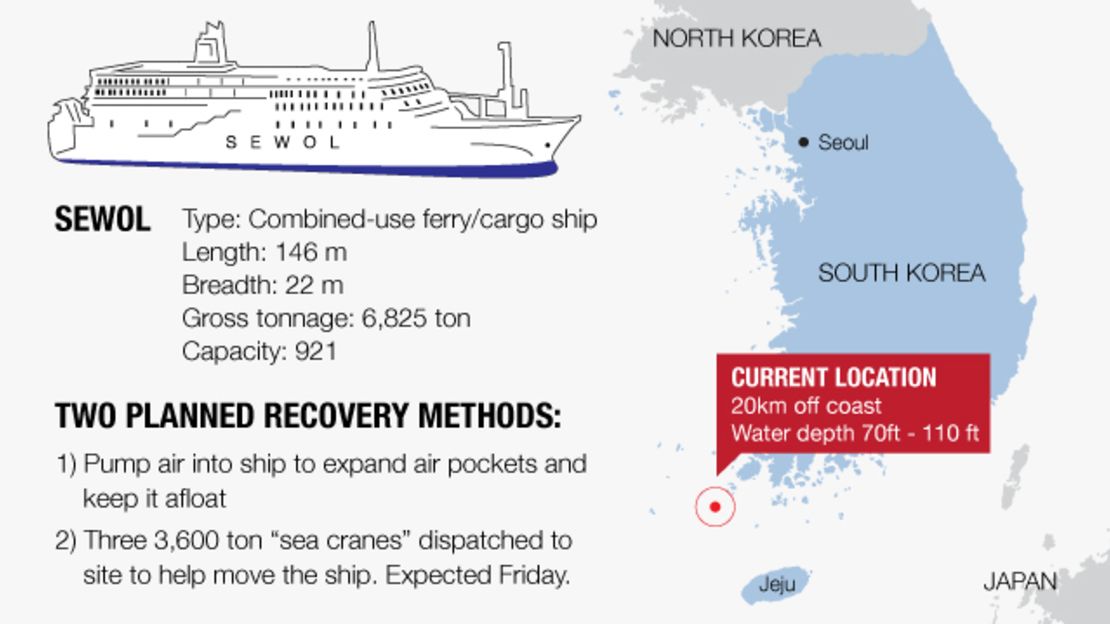Story highlights
NEW: The death toll has risen to 146, authorities say
No bodies found in cafeteria, where many people were thought to have been
Crew made a distress call three minutes after passenger, South Korean coast guard says
Nine crew members facing charges in ferry sinking
The first distress call from the ferry Sewol came not from the crew, but from a boy who used a cell phone to contact emergency services from aboard the sinking ship, the South Korean coast guard confirmed to CNN Tuesday.
CNN affiliate JTBC reported that the boy dialed South Korea’s emergency number, telling dispatchers for a local fire service, “Help us. The boat is sinking.” The boy’s fate was not clear.
It was not until three minutes later, the coast guard told CNN, that the ship’s crew made a distress call to maritime officials.
The revelation is likely to add to questions about the conduct of the crew, nine of whom are facing charges in last week’s sinking.
Among other things, authorities have questioned why an inexperienced third mate was guiding the ship at the time of the accident, why so few of the ferry’s life rafts were deployed and why crew members ordered passengers to don life vests and stay put.
At least 146 people are confirmed dead, according to the joint task force leading the search. Earlier, when the death toll was reported to be 128, authorities had said that 174 people were still missing.
The death toll had been expected to climb as divers were able to reach the ship’s cafeteria, where many passengers were thought to be when the ship began to have troubles last week. But early Wednesday, the coast guard said no bodies had been found in the cafeteria.
Search for survivors goes on
Rescuers will continue to focus on the third and fourth decks of the five-level ship, said Koh Myung-seok, a spokesman for the joint task force.
Above the ship, two buoys marked its location in the water, surrounded by dozens of vessels, ranging from dinghies to warships. Inflatable powerboats zipped across the sea, ferrying divers to the area.
Searchers used guide ropes to lead them into the submerged ferry.
“Divers can’t even see their hands,” Koh said.
Bard Yoon, one of the divers, said conditions are so bad “my heart aches.”
“We’re going in thinking there may be survivors,” he said. “When we have to come back with nothing, we can’t even face the families.”
On shore, relatives of missing passengers waited anxiously, many of them parents of high school students who were on a field trip. As bodies come in, they are called into white domed tents to identify the remains of their loved ones.
Authorities said the efforts are still a search and rescue operation, but no survivors have been found since 174 people were rescued soon after the ferry went down.

Captain and crew criticized
As the search continues, investigators are trying to figure out what happened to make the ship list before finally capsizing and sinking into the ocean.
Initial criticism has focused on the captain and some crew members. South Korean President Park Geun-hye said Monday that their actions were “akin to murder.”
The captain, Lee Joon-seok, has defended his decision to tell passengers to stay put as the ferry began sinking, saying he was concerned about the sea’s strong currents and cold water as well as the lack of rescue ships.
Questions have been raised about why the third mate was steering the ship when it ran into trouble on its way to a popular vacation island. The captain was in his cabin at the time.
Chonghaejin Marine, which operated the ferry, has posted an apology on its website.
“We pray for the Sewol victims who lost their precious lives due to the accident,” it said. “We prostrate ourselves before the victims’ families and beg for forgiveness.”
In recent maritime disasters, captains didn’t hang around
Students remember vice principal who took own life
Murky waters cloud the horror facing rescue divers
CNN’s Kyung Lah and K.J. Kwon reported from Jindo, and CNN’s Michael Pearson reported and wrote from Atlanta. CNN’s Jethro Mullen, Khushbu Shah, Tim Schwarz, Steven Jiang and Judy Kwon, journalists Stella Kim and Jung-eun Kim, and translator Hyoun Joo Song also contributed to this report.







